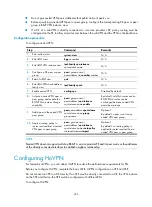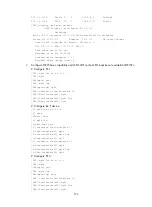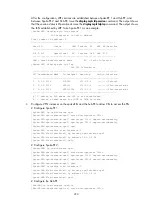
277
[PE1-bgp-vpn1] quit
[PE1-bgp] ipv4-family vpn-instance vpn2
[PE1-bgp-vpn2] peer 10.2.1.1 as-number 65420
[PE1-bgp-vpn2] import-route direct
[PE1-bgp-vpn2] quit
[PE1-bgp] quit
# Configure PE 2 in a similar way as you configure PE 1. (Details not shown.)
After completing the configurations, issue the
display bgp vpnv4 vpn-instance peer
command on
the PEs. The output shows that BGP peer relationship has been established between PE and CE,
and has reached the Established state. Take PE 1 as an example:
[PE1] display bgp vpnv4 vpn-instance vpn1 peer
BGP local router ID : 1.1.1.9
Local AS number : 100
Total number of peers : 1 Peers in established state : 1
Peer AS MsgRcvd MsgSent OutQ PrefRcv Up/Down State
10.1.1.1 65410 11 9 0 1 00:06:37 Established
5.
Configure MP-IBGP peers between PEs:
# Configure PE 1.
[PE1] bgp 100
[PE1-bgp] peer 3.3.3.9 as-number 100
[PE1-bgp] peer 3.3.3.9 connect-interface loopback 0
[PE1-bgp] ipv4-family vpnv4
[PE1-bgp-af-vpnv4] peer 3.3.3.9 enable
[PE1-bgp-af-vpnv4] quit
[PE1-bgp] quit
# Configure PE 2.
[PE2] bgp 100
[PE2-bgp] peer 1.1.1.9 as-number 100
[PE2-bgp] peer 1.1.1.9 connect-interface loopback 0
[PE2-bgp] ipv4-family vpnv4
[PE2-bgp-af-vpnv4] peer 1.1.1.9 enable
[PE2-bgp-af-vpnv4] quit
[PE2-bgp] quit
After completing the configuration, issue the
display bgp peer
command or the
display bgp vpnv4
all peer
command on the PEs. The output shows that BGP peer relationship has been established
between the PEs, and has reached the Established state.
[PE1] display bgp peer
BGP local router ID : 1.1.1.9
Local AS number : 100
Total number of peers : 1 Peers in established state : 1
Peer AS MsgRcvd MsgSent OutQ PrefRcv Up/Down State
3.3.3.9 100 2 6 0 0 00:00:12 Established
6.
Verify your configuration:
Issue the
display ip routing-table vpn-instance
command on the PEs. The output shows the routes
to the CEs. Take PE 1 as an example:
[PE1] display ip routing-table vpn-instance vpn1
















































